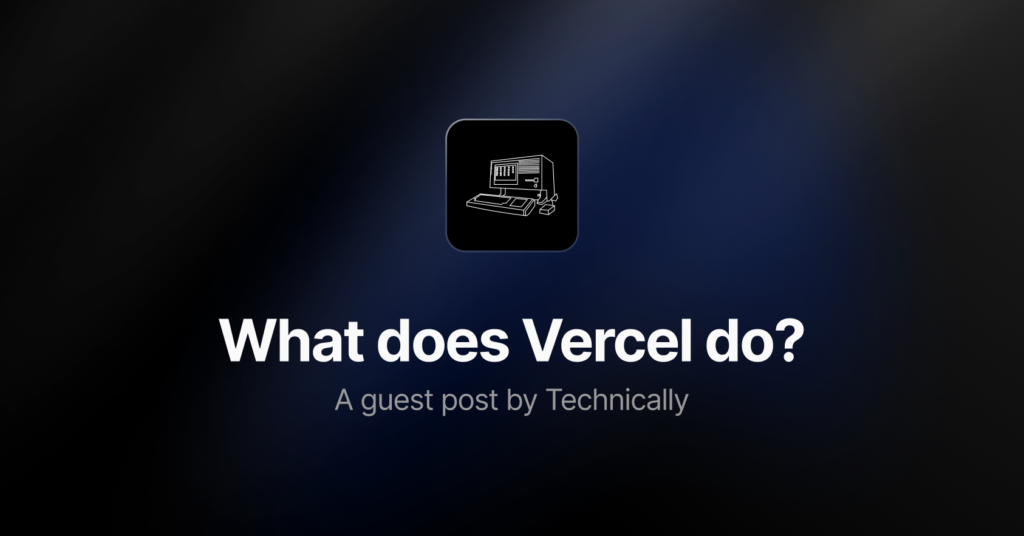Overview of Vercel
Vercel Inc., originally founded as ZEIT in 2015 by Guillermo Rauch, is an American cloud platform as a service (PaaS) company that focuses on enabling developers to build and deploy web applications efficiently. The company is best known for maintaining Next.js, a popular React-based web development framework that supports server-side rendering and static site generation. In April 2020, ZEIT rebranded to Vercel, while retaining its triangular logo, symbolizing its commitment to innovation in web development.Vercel’s primary mission is to provide a seamless developer experience through its Frontend Cloud, which integrates various tools and services that streamline the process of building, deploying, and scaling web applications. The platform is designed to enhance performance, security, and accessibility, making it a preferred choice for many developers and enterprises.
Key Features of Vercel
- Deployment Automation: Vercel automates the deployment process through integration with Git repositories, supporting platforms such as GitHub, GitLab, and Bitbucket. This allows developers to deploy their applications with minimal effort, as changes pushed to the repository are automatically reflected in the live application.
- Serverless Functions: Vercel supports serverless functions, enabling developers to run backend code without managing servers. This feature simplifies the development of dynamic applications and APIs.
- Global CDN: Vercel leverages a global Content Delivery Network (CDN) to ensure fast loading times for applications, regardless of user location. This is crucial for enhancing user experience and engagement.
- Custom Domains: While Vercel provides automatic subdomains under
vercel.app, it also allows users to configure custom domains for their applications, enhancing branding and professionalism. - Real-time Collaboration: Vercel’s platform facilitates real-time collaboration among developers, allowing teams to work together seamlessly on projects.
Architecture and Technology Stack
Vercel’s architecture is built around a composable design, which allows for flexibility and scalability. The platform utilizes Amazon Web Services (AWS) and Cloudflare for its infrastructure, ensuring reliability and performance.The deployment process typically involves the following steps:
- Code Commit: Developers push their code to a Git repository.
- Automatic Deployment: Vercel detects the changes and automatically builds and deploys the application.
- Live Updates: The application is updated in real-time, allowing users to see changes immediately.
Clientele and Market Position
Vercel has gained significant traction among leading companies and organizations. Its clientele includes notable names such as Airbnb, Uber, GitHub, Nike, Ticketmaster, Carhartt, IBM, and McDonald’s. The platform’s ability to handle high-traffic applications and its focus on performance have positioned it as a leader in the cloud services market.
Financial Growth
In June 2021, Vercel raised $102 million in a Series C funding round, valuing the company at approximately $3.25 billion as of May 2024. This financial backing has allowed Vercel to expand its offerings and enhance its platform capabilities.
Acquisitions
Vercel has also made strategic acquisitions to bolster its technology stack. In December 2021, it acquired Turborepo, a build system for monorepos, and in October 2022, it acquired Splitbee, a tool for analytics and user engagement.
Comparison with Competitors
Vercel competes with other cloud platforms such as Netlify, AWS Amplify, and Firebase. While all these platforms offer similar services, Vercel distinguishes itself through its focus on the frontend development experience, particularly with Next.js, which is widely regarded for its performance and developer-friendly features.
Vercel and Next.js
Next.js is a framework developed by Vercel that allows developers to create server-rendered React applications. It simplifies the process of building complex web applications by providing features such as:
- Server-Side Rendering (SSR): This allows pages to be rendered on the server, improving performance and SEO.
- Static Site Generation (SSG): Developers can pre-render pages at build time, delivering faster load times.
- Incremental Static Regeneration (ISR): This feature allows developers to update static content without rebuilding the entire site.
Next.js has become a staple in the React ecosystem, and its integration with Vercel enhances its capabilities, providing a comprehensive solution for modern web development.
FAQ Section
What is Vercel?
Vercel is a cloud platform that provides tools and infrastructure for developers to build, deploy, and scale web applications efficiently. It is known for its integration with the Next.js framework.
Who founded Vercel?
Vercel was founded by Guillermo Rauch in 2015. It was initially named ZEIT before rebranding to Vercel in 2020.
What is Next.js?
Next.js is an open-source web development framework created by Vercel that enables developers to build server-rendered and static web applications using React.
How does Vercel handle deployments?
Vercel automates the deployment process through integration with Git repositories, allowing developers to deploy their applications with minimal effort. Changes pushed to the repository trigger automatic deployments.
What are serverless functions in Vercel?
Serverless functions are a feature of Vercel that allows developers to run backend code without managing servers. This simplifies the development of dynamic applications and APIs.
Who are Vercel’s clients?
Vercel serves a diverse clientele, including major companies such as Airbnb, Uber, GitHub, Nike, Ticketmaster, Carhartt, IBM, and McDonald’s.
What is the financial status of Vercel?
As of May 2024, Vercel is valued at approximately $3.25 billion following significant funding rounds, including a $102 million Series C round in June 2021.
How does Vercel compare to its competitors?
Vercel competes with platforms like Netlify, AWS Amplify, and Firebase, focusing on providing an exceptional frontend development experience, particularly through its integration with Next.js.
Summary Table
| Feature | Description |
|---|---|
| Founded | 2015 (as ZEIT) |
| CEO | Guillermo Rauch |
| Headquarters | San Francisco, California, USA |
| Valuation | $3.25 billion (as of May 2024) |
| Key Product | Next.js |
| Deployment Method | Automated through Git integration |
| Infrastructure | Utilizes AWS and Cloudflare |
| Notable Clients | Airbnb, Uber, GitHub, Nike, Ticketmaster, IBM, McDonald’s |
| Acquisitions | Turborepo (2021), Splitbee (2022) |
For more detailed information, you can refer to the Vercel Wikipedia page.
Read more about it:https://greyhoundsverdevalley.com/who-won-american-ninja-warrior-2023/



